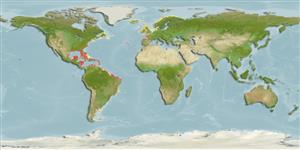Bivalvia |
Mytilida |
Mytilidae
Environment: milieu / climate zone / depth range / distribution range
Ecology
Benthic; depth range 1 - 23 m (Ref. 83435). Tropical
Atlantic Ocean.
Length at first maturity / Size / Weight / Age
Maturity: Lm ? range ? - ? cm Max length : 12.0 cm DL male/unsexed; (Ref. 83435)
Commensal with amphipods (Ref. 82302). Found boring in corals (Ref. 75840).
Life cycle and mating behavior
Maturity | Reproduction | Spawning | Eggs | Fecundity | Larvae
Members of the class Bivalvia are mostly gonochoric, some are protandric hermaphrodites. Life cycle: Embryos develop into free-swimming trocophore larvae, succeeded by the bivalve veliger, resembling a miniature clam.
Gischler, E. and R.N. Ginsburg 1996 Cavity dwellers (coelobites) under coral rubble in southern Belize barrier and atoll reefs. Bull. Mar. Sci. 58(2):570-589. (Ref. 86352)
IUCN Red List Status
(Ref. 130435: Version 2025-1)
CITES status (Ref. 108899)
Not Evaluated
Not Evaluated
Threat to humans
Human uses
| FishSource |
Tools
More information
Trophic EcologyFood items (preys)
Diet composition
Food consumption
Predators
Population dynamicsGrowth
Max. ages / sizes
Length-weight rel.
Length-length rel.
Length-frequencies
Mass conversion
Abundance
Life cycleReproductionMaturityFecunditySpawningEggsEgg developmentLarvae PhysiologyOxygen consumption
Human RelatedStamps, coins, misc.
Internet sources
Estimates based on models
Preferred temperature
(Ref.
115969): 7.4 - 28, mean 17.9 (based on 1177 cells).
Fishing Vulnerability
Low vulnerability (10 of 100).
